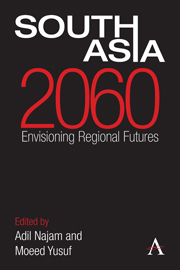Book contents
- Frontmatter
- Contents
- Acknowledgments
- List of Abbreviations
- Introduction: Imagining South Asian Futures
- Section I South Asia as a Region
- Chapter 1 Prisoners or Masters of Destiny?
- Chapter 2 South Asian Futures: Three Scenarios
- Chapter 3 Federalism on the Road: Region and Regionalism
- Chapter 4 Diversity in South Asia
- Chapter 5 Future's Past
- Section II State Relations
- Section III Development
- Section IV Human Well-Being
- About the Authors
- Bibliography
- Index
Chapter 4 - Diversity in South Asia
from Section I - South Asia as a Region
Published online by Cambridge University Press: 05 September 2013
- Frontmatter
- Contents
- Acknowledgments
- List of Abbreviations
- Introduction: Imagining South Asian Futures
- Section I South Asia as a Region
- Chapter 1 Prisoners or Masters of Destiny?
- Chapter 2 South Asian Futures: Three Scenarios
- Chapter 3 Federalism on the Road: Region and Regionalism
- Chapter 4 Diversity in South Asia
- Chapter 5 Future's Past
- Section II State Relations
- Section III Development
- Section IV Human Well-Being
- About the Authors
- Bibliography
- Index
Summary
Is diversity of population, belief or culture good or bad? There is no consensus on this point, nor has there ever been. Almost by definition, diversity is implicit in empire. Yet empires tend to fall in pieces because of disunity. For nationalists, diversity is generally undesirable and has sometimes been persecuted. If moral issues bulk so large as to make intolerance a virtue, diversity appears evil. But if cultural, particularly artistic, fertility is the objective, the evidence is overwhelmingly in favor of diversity. Diversity implies compromise. Compromise is good if it resolves disputes but is of dubious value if it merely papers over divisions, which later break forth more strongly.
In the South Asia of the twenty-first century it is not useful and might indeed be dangerous to promote diversity or alternatively to seek to reduce it. So much depends upon what sort of diversity is at stake and upon the quality of the ideas supporting it. This essay deals with a few of the diversities, particularly economic, cultural and religious, as they affect India and Pakistan. A brighter South Asian future requires, foremost, a deal between these two primary parties. Yet, the inevitable political difficulties involved could be reduced if both parties know that they will be able to present a compromise in the context of a wider South Asian plan for the future.
- Type
- Chapter
- Information
- South Asia 2060Envisioning Regional Futures, pp. 38 - 45Publisher: Anthem PressPrint publication year: 2013



